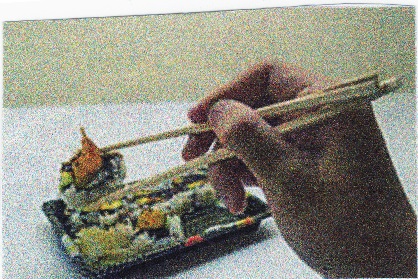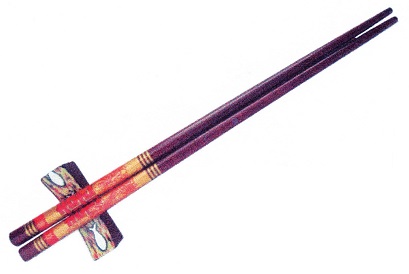
| What is Flavor and Fortune? |
| How do I subscribe? |
| How do I get past issues? |
| How do I advertise? |
| How do I contact the editor? |
Read 12925167 times
Connect me to:
| Home |
| Articles |
| Book reviews |
| Letters to the Editor |
| Newmans News and Notes |
| Recipes |
| Restaurant reviews |
| Article Index (all years, slow) |
| List of Article Years |
| Article Index (2025) |
| Article Index (last 2 years) |
| Things others say |
| Related Links |
| Log In... |
| Authors |
| Categories & Topics |
Chopsticks Throughout History
| by Jacqueline M. Newman |
Food in History
Summer Volume: 2017 Issue: 24(2) pages: 12 to 13
Many wonder when these two equal length sticks were first used. It certainly was centuries before forks and other table utensils were commonplace. They probably were in use during the Xia Dynasty, circa 21st to 16th centuries BCE, and certainly were used during the Shang Dynasty (1766 - 1122 BCE) when King Zhou wanted and ordered some made of elephant teeth for his own use. More common knowledge about chopsticks existed circa 1122 - 770 BCE when many in China were made of bamboo.

The very earliest sticks may have been twigs used to retrieve foods cooking in hot liquids. By 500 BCE, their popularity was also common in Japan, Vietnam, and Korea. Then, the Chinese called them zhu, and now they call them kuaizi which means ‘quick’ or ‘quick boys’ and some call them ‘chop chop.’ What do you call them?
In the early years, women’s chopsticks in China were one-inch shorter than those for men; children’s shorter still. The Japanese make theirs with pointed ends, the Chinese make theirs with blunt ends; and in both countries, bamboo chopsticks were and are most popular materials they are made with.
None remain of any wood because wood rots. We do know that those of bamboo were written about in the early years, and the ones found of bronze. Some were in the ruins of Yin near Anyang; we now call that Henan. A few other old ones were found made of coral, a few of elephant teeth or tusk, and others of metal or another hard material. Sticks to eat one’s food were written about in Feizi by Han Fei circa the 3rd century BCE.
These days, Chinese chopsticks are about twelve inches in length, longer than both Japanese and Korean ones. Those from those two countries are round, one end to the other, while Chinese ones are square on the top half, round on their lower halves.
People in these three countries use them most often, more than folks in any other countries. They yell us to be careful not to take food from a serving dish with sticks that were in ones mouth, so we all do need to observe this protocol for health and for other reasons. Be aware that in some countries, including Laos, Thailand, and Nepal, they only use chopsticks for eating noodles. Did you know that?
There are many other chopstick rules of etiquette such as never knocking yours on the side of a dish nor tapping them on the table because these are the sounds of beggars asking for food. Another is not using them to stir your food as that is rude to the person who cooked it. Do not point them at another person, never dig in a dish with them, do not lick their ends, nor stand them upright in a dish. This last activity looks like you are honoring the dead because incense looks like that at funerals.
Most people do not know that long ago, the Chinese only used chopsticks for their side dishes. They never held them with their left hand because they could knock food out of the hand of a person on their left. There are other taboos or information about them including that before the Ming Dynasty (1368 CE), the Chinese did not use chopsticks to eat rice, spoons were for that purpose. They should not be used to bring serving dishes closer, scoop up food, let liquids drip from their tips, use them to beat foods, or grip them looking as though ready to attack.
To use yours properly, the lower stick needs to be held stationary, the upper one held like a pencil with thumb, index finger, and middle finger to get food from serving dish or your plate to mouth. Yes, it is polite to hold one’s rice bowl and bring it to the mouth and then shovel one’s rice into it.

These days, there are new uses for chopsticks. Many are used as wedding gifts to signify wishes the recipient have a son soon. There are those that collect them so they make fine gifts for any reason and any occasion. Extra long ones and/or extra fancy ones are popular for serving or cooking, most made of materials that do not conduct heat. One exception to this is in Korea where almost all chopsticks are made of metal. Restaurants often use plastic ones for durability and sanitation. They can and do go in a dishwasher. Now for three other items. At the end of a restaurant meal, many waiters cross a pair of chopsticks on a rice bowl to tell others not to serve any more food there, as their bill has been calculated. Many eateries now using disposable chopsticks. Many of their customers object because some forty-five billion pairs, an amount said to be the annual destruction of twenty-five million fully grown trees, are being disposed of. And in China, chopsticks are lightened with bleach, a technique frowned upon.
American chopsticks are not bleached because they are made with sweet gum, poplar, or a similar wood that does not need lightening. One study shows elderly having increased risk of osteoarthritis in their right hand, may lead to swelling in joints of that hand.
Chopstick lore includes many truths and myths. In the latter category are tales that if one gets an uneven pair, that person will miss a plane or boat, if one uses silver chopsticks they recognize poisons and turn black, and the closer one holds them to their lower end, the longer one will remain unmarried. Though these ‘quick boys’ are adored by many, so is another myth, that using chopsticks makes one very clever.
Millions use them at every meal three times every day on every continent worldwide. They are popular eating implements used by people of all ages; are you one who eats faster with them than with any another implement?

Copyright © 1994-2025 by ISACC, all rights reserved
Address
3 Jefferson Ferry Drive
S. Setauket NY 11720